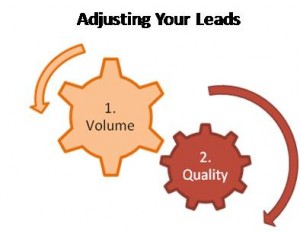In the MECLABS Conversions Group, we spend a lot of our time trying to reduce the friction and anxiety inherent in our Research Partners’ sales funnels …since we have less control of the visitor’s motivation or the value of the product, service or incentives.
However, I have one Research Partner that values friction in their lead generation process.
Why would they value friction?
They have live, certified counselors who follow up with each and every lead. So the better those leads are qualified for the sale the better it is for this Research Partner since it takes a significant investment in personnel time and energy to work through each lead. This is an important consideration when we are analyzing the sales process for our Research Partners.
For a funnel that requires the human touch
So I look at friction in this situation as traction on the road to the sale. Just think about it, if you have no traction when you are taking a corner in your car and you end up in the ditch, you’re stuck and in trouble. Or, to extend the metaphor to the sales process, your visitors and potential customers don’t end up where you want them to be. It can get pretty messy and you don’t get them to their destination, buying your goods or services.
 Dr. Flint McGlaughlin, Managing Director, MECLABS, relates an image of two dials. The more friction you have, the fewer prospects, but if done correctly, they will be better qualified and you will waste less of your sales force’s time chasing down weak leads while having more traction with better leads.
Dr. Flint McGlaughlin, Managing Director, MECLABS, relates an image of two dials. The more friction you have, the fewer prospects, but if done correctly, they will be better qualified and you will waste less of your sales force’s time chasing down weak leads while having more traction with better leads.
So if your business model is based on live sales follow up, you will need to add a phone number to your lead generation form at the very least. But what else should you add? And should those fields be required to get something of value (say, a webinar of white paper) in which case visitors may enter garbage data, or can you live with optional fields?
Visitors who willingly enter optional data are much more likely to be quality leads, and you can send the leads that just entered the required information for further nurturing. But it helps to set an overall goal up front, do you just want a mass volume of “leads” or truly qualified leads that can maximize your overall goal – profit.
For an online-only sales process
When evaluating the information you are looking to gather in your lead generation efforts for an online-only effort, always ask yourself what the minimum amount of information you really need is. For a strictly electronic lead nurturing process, this may be as little as an email address. I always want to also get a first name, so that any appeals may be personalized.
Certainly in a completely online sales process there is no limitation on the number of visitors you may serve since there is not an incremental cost for each new lead. So reduce that friction as much as you possibly can because there is not an organizational ditch to run into (wasted effort trying to sell to non-qualified leads). There is a qualifier to this…
For an online-only sales process that pays per click
Traction isn’t only important in the form, it can be important before they even get to the form. If you’re engaging in PPC (pay-per-click) advertising, all those wasted clicks that don’t convert are costing you real money.
For example, in a recent test on an online sales process, the Research Partner had a number of affiliate marketing partners and they had ads on these partner sites. We are working with the company to increase their overall conversions. In evaluating the banners that have been in place to promote the offer, we found that they were getting a significant click-through rate, but low conversions.
In redesigning the banners we clarified the offer and the call to action. The result was:
- A decrease in clicks by 34.93%
- But an increase in conversions of 22.2%
- So the close rate on the new banner was 87.8%!
The 34.93% decrease was a huge positive. Many people who weren’t really interested were just enticed by the ad to click and, essentially, sliding into a page they had no intention of converting on and then bouncing (into a ditch, so to speak).
Of course, the clearer ads created friction. People were far less likely to click on them. However, the one that did had the traction to continue on through the path to conversion, the ultimate goal.
So remember, when you’re looking to optimize your banners, sales pages, or landing pages, friction can be good. The click is one goal, but you want to get the click from somebody who needs your product or service and is in a position to buy. That’s where the money is.
Related Resources:
Improving Conversion by 162%: How to Overcome Value Inhibitors
Lead generation optimization: Finding the right amount of friction



Traction isn’t only important in the form, it can be important before they even get to the form.If you’re engaging in PPC (pay-per-click) advertising, all those wasted clicks that don’t convert are costing you real money.